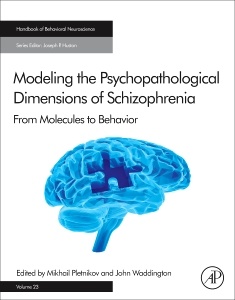Modeling the Psychopathological Dimensions of Schizophrenia From Molecules to Behavior Handbook of Behavioral Neuroscience Series
Coordonnateurs : Pletnikov Mikhail, Waddington John

Modeling the Psychopathological Dimensions of Schizophrenia: From Molecules to Behavior is the first book to offer a comprehensive review of the new theoretical, clinical, and basic research framework that considers psychotic illness as a group of dimensional representations of psychopathology rather than as traditional distinct categorical diagnoses. Psychotic illness, typified by schizophrenia, is a devastating condition increasingly recognized as a disorder of abnormal brain development and dysconnectivity. Its complex etiology involves both genetic and environmental factors, as well as the interplay among them.
This book describes the current understanding of the clinical and pathological features of schizophrenia, with a particular focus on the evolving conceptualization of schizophrenia and related diagnostic categories of psychotic illness as combinations of dimensional abnormalities. It provides an overview of modern strategies for generating cellular and whole animal models of schizophrenia as well as detailed reviews of the specific experimental preparations and paradigms aimed at molecular, developmental, and brain-network mechanisms that are the underlying aspects of abnormal behavior and various aspects of schizophrenia.
This groundbreaking book is an authoritative overview of the translational impact of emerging clinical insights on basic research approaches in schizophrenia that will advance the reader?s understanding of the five major dimensions of psychopathology in schizophrenia and related psychoses and resolve the genetic and neurobiological underpinnings of these dimensions.
Part I: From Clinical Dimensions to Animal Models Clinical and Pathological Aspects 1. Overview of Schizophrenia: Dimensions of Psychopathology 2. Overview of Schizophrenia: Epidemiology and Pathobiology Animal Models of Psychotic Disorders: Dimensional Approach 3. Overview of the Dimensional Approach in Basic Research 4. Modeling Positive Symptoms 5. Modeling Negative Symptoms 6. Modeling Cognitive Impairment 7. Modeling Affective Symptoms
Part II: Neurobiology of Psychotic Disorders Non-Genetic Models 8. MAM-Related Models 9. Social Isolation Models 10. Pharmacological/Substance Abuse Models 11a. Etiological Environmental Models: Maternal Immune Activation 11b. Etiological Environmental Models: Viral Infection Models 11c. Etiological Environmental Models: Stress Models 12. Toxoplasma Models 13. Nutritional Alterations Genetic Models 14a. Mouse Models: Risk Genes 14b. Mouse Models: CNV Models 15. Rat Models Gene-Gene and Gene-Environment Models 16. Gene-Gene Models 17. Gene-Environmental Models 18. Rodent Models of Multiple Environmental Exposures with Relevance to Schizophrenia Cell Models 19. Synaptic Abnormalities and Neuroplasticity 20. iPS Models 21. Olfactory Epithelium and iN Models 22. Neuron-Glia Interaction Molecular Studies 23. Intracellular Signaling 24. Hormones 25. Oxidative Stress 26. Immune Dysregulation; Autoantibodies 27. Future Directions
Researchers and graduate students in clinical neuroscience, translational neuroscience, behavioral neuroscience, neurobiology, clinical psychiatry, and pharmaceutical science
John Waddington is currently Professor of Neuroscience in Molecular and Cellular Therapeutics at the Royal College of Surgeons in Ireland (RCSI), Dublin. He received a BA in Natural Sciences from the University of Cambridge, and a PhD in Neuropharmacology followed by a DSc in Neuroscience from the University of London. After working with the UK Medical Research Council in the Division of Psychiatry at their Clinical Research Centre, he joined RCSI and became Chairman of Clinical Pharmacology in 2004. In 2003, he became the first person from RCSI to be elected to membership of the Royal Irish Academy; he has received the Lilly Neuroscience Award from the International College of Neuropsychopharmacology and the Award for Outstanding Achievement in Basic Science from the Schizophrenia International Research Soci
- Includes reviews of animal models that capture the most recent insights into the etiology and pathogenetic mechanisms of schizophrenia, with an emphasis on the translational potential of these models
- Contains a series of reviews of recently available cellular models for analysis of signaling pathways and gene expression, which complement behavioral neuroscience research in schizophrenia
- Edited and authored by leading researchers in the field of schizophrenia and related psychoses
Date de parution : 11-2015
Ouvrage de 548 p.
21.4x27.6 cm



